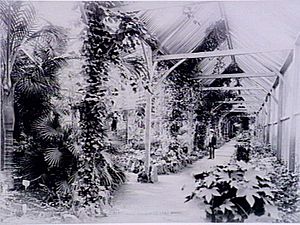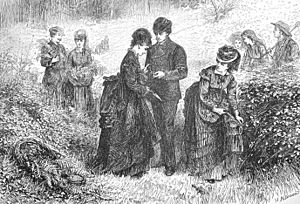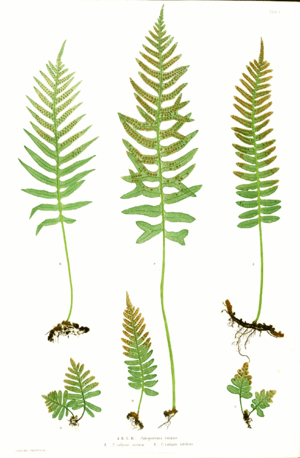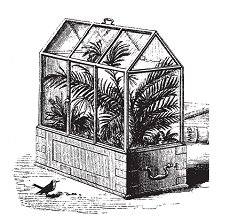Pteridomania facts for kids
Pteridomania (say: ter-id-oh-MAY-nee-uh), also called fern fever, was a huge craze for ferns that swept through Victorian Britain. This happened mostly in the 1800s. People loved ferns so much that you could see fern designs everywhere! They were on pottery, glass, metal, fabrics, wood, and even gravestones. It was like ferns were the most popular plant of the time.
Contents
What Was Pteridomania?
The word Pteridomania means Fern Madness or Fern Craze. It comes from Pteridophytes, which is the scientific name for ferns, and mania, meaning a strong obsession. A writer named Charles Kingsley first used this word in 1855. He wrote about how people, especially young women, became very excited about collecting and learning about ferns. He even said it made them more active and cheerful than reading novels or doing needlework!
The fern craze was most popular from the 1850s to the 1890s. But interest in ferns actually started earlier, around the 1830s. At that time, more and more people in Britain became interested in studying plants. Ferns were a great group to study because they hadn't been explored as much as flowering plants. Also, many ferns grew in the wilder, wetter parts of Britain, which became easier to reach thanks to new roads and railways.
Collecting and Growing Ferns
People from all walks of life, rich or poor, joined the fern craze. It's said that even miners and farm workers had their own collections of British ferns. This shared interest sometimes brought people from very different social backgrounds together.
For some, collecting ferns was a fun hobby. For others, it was a serious scientific pursuit. Soon, businesses started selling things for fern collectors. People bought books to help them identify ferns. They searched for ferns in the wild across Britain and even other parts of the world. Collectors would press fern leaves into special albums to display in their homes.
Many people also collected live ferns to grow in their gardens or indoors. Plant nurseries sold both native ferns and exotic ones from places like the Americas.
The Wardian Case
A special invention called the Wardian case helped people grow ferns indoors. This was like an early version of a terrarium. It was invented around 1829 by Nathaniel Bagshaw Ward. He created it to protect his ferns from the dirty air in 19th-century London. Wardian cases soon became popular decorations in fancy homes in Europe and the United States. They helped the fern craze spread even further. People also grew ferns in special greenhouses called fern houses or in outdoor fern gardens called ferneries.
Besides the about seventy native British fern types, gardeners were very interested in unusual fern varieties. These were called monstrosities because they looked different from the usual wild ferns. From these, hundreds of new varieties were chosen for growing. For example, some common fern types each produced about 300 different varieties!
Ferns in Art and Design
Fern designs became very noticeable at the 1862 International Exhibition, a big world's fair. They stayed popular as a symbol of enjoyable activities until the early 1900s.
Because fern leaves are quite flat, they were perfect for decorating in ways other plants couldn't be. People glued them into collector's albums. They stuck them onto objects. They used them as stencils for "spatter-work" art. They also inked ferns and pressed them onto surfaces to make "nature prints."
Many famous pottery companies like Wedgwood and Royal Worcester made pottery with fern patterns. These items came in different shapes and styles. A special memorial for Sir William Jackson Hooker, a director of the Royal Botanic Gardens, Kew, was made in 1867. It had panels with designs of exotic ferns. A copy of this memorial can still be seen today at the Victoria and Albert Museum.
Even when fern designs were simplified, like on engraved glass or metal, they still looked clearly like ferns.
Impact on Wild Ferns
The strong desire of Victorian collectors led to a big drop in the number of some rare fern types in the wild. For example, the Oblong Woodsia fern was severely threatened in Scotland. This area used to have the most of these ferns in the UK. Now, only a few small groups remain, and they are still at risk. The Alpine Woodsia fern faced a similar problem.
Collecting ferns could even be dangerous. One plant expert almost died trying to get a fern from a cliff. Another guide died collecting Alpine Woodsia in Wales in 1861. His body was found at the bottom of the cliff. A writer named Nona Bellairs even suggested creating "Fern laws" to protect ferns from being over-collected.
The Killarney Fern is one of Europe's most threatened plants. It was once found on the Isle of Arran and was thought to be gone from Scotland because of 19th-century collectors. However, it has since been found on the Skye island. The Dickie's Bladder-fern was discovered in a sea cave in 1838. By 1860, the original group of plants seemed to have disappeared. But the species has recovered, and today there are over 100 plants there.
Pteridomania Around the World

Pteridomania is often seen as a unique British obsession. However, historians disagree on how much it spread outside the United Kingdom. Some believe it didn't really catch on in America because American ferns didn't have as many of the "freaky" unusual forms that British collectors loved. Also, American plant experts were more focused on understanding the different types of ferns.
On the other hand, historian Sarah Whittingham has found evidence that the fern craze did reach America. The American Fern Society was started in 1893 and now has over 900 members worldwide. It is one of the largest international fern clubs.
The Dorrance H. Hamilton Fernery at the Morris Arboretum in Pennsylvania is the only Victorian fernery left in North America. It has a curved glass roof and was 100 years old in 1999. This fernery shows the Victorian love for collecting, nature, and romantic gardens.
Pteridomania also had negative effects in Australia. In Queensland, ferns were taken from their natural homes to meet the demand of collectors. Epiphytic ferns, like Staghorns and Bird's nests, were collected from the wild. They became popular decorations that people could hang. It was common in Queensland to see staghorns decorating public buildings and train stations. This practice continued for many years.





